Parks
Parks
Locate in the west bank of Erhai Lake, Haishe Ecological Park(海舌公园) is about 3-4 kilometers away from Xizhou. It is a narrow peninsula that extends into the Erhai Sea. It enjoys the picturesque scenery and the crystal water of Erhai Lake. It is an approving place for taking photos. The green willows stand along the coast, and the scenery on both sides of the straits are different. The four seasons are picturesque, and it is the best place to watch the Erhai Lake.
When the weather is fine in Dali, the sunshine is heated, and ultraviolet light is strong. People should avoid direct sunlight, and the sun hat preparation is required during outdoor activities, a pair of sunglasses will make you comfortable in the trip.
Travelers can visit the Xizhou Ancient Town and Haishe Park together.
It is convenient for travelers to go to Haishe Park by taxi, but hard to get back. Therefore, travelers had better ask the taxi driver to waiting outside.
Reflection Park(倒影公园) is behind the Three Pagodas, and there is a Reflection Pond in the park which got its name from the graceful clear reflections on the water of the Three Pagodas of Chongsheng Temple. The authentic Three Pagodas and the reflections create a fantastic pictures – six pagodas in one scene. Travelers, especially photographers, should cover the Reflection Pond into your visit for some awesome pictures. With the diverse directions, travelers can appreciate the differnt relections of the Three Pagodas. In winter, Cangshan Mountain was covered by snow. The reflection will be more charming and unique.
The oval reflection pool is clean and quiet. The most distinctive feature of the reflection park is that pool can reflect the Three Pagodas of Chongsheng Temple.
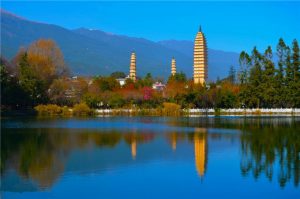
The park was built in the 1980s. The poolside is decorated with silver birch, cedar, weeping willow, etc. It is surrounded by rattan frames, marble tables and benches, long columns and small streams around the lake. On the west side of the pool, there is a Dali monument pavilion. Walking along the corridor, travelers can get to Yangbo Pavillion in the pool. There is a small island on the south side of Libo Pavilion, with a pair of vivid white cranes statues on the island.
When the weather is fine in Dali, the sunshine is heated, and ultraviolet light is strong. People should avoid direct sunlight, and the sun hat preparation is required during outdoor activities, a pair of sunglasses will make you comfortable in the trip.
The reflection park deserves to visit when you visit the Three Pagodas. It is the ideal place for you to appreciate the whole view of the Three Pagodas.
Three Pagodas in Dali
Cangshan Mountain
Dali Ancient Town
Erhai Lake
Erhai Lake Park(洱海公园) is a park at the southern end of the Erhai Sea in Dali City, Yunnan Province. It is the first stop to visit the Cangshan and Erhai Scenic Area. The pavilions, terraces and buildings echo each other. It has become the largest comprehensive park with the complete facilities in Dali. The sea water temperature is around 7 °C even in the winter and summer, especially for winter swimming. Today, Erhai Park has become an important flower breeding base in western Yunnan.
Erhai Lake Park is located in the east end of Erhai Lake. It is the first station for the Cangshan and Erhai tour. In December of 1976, the Erhai Lake Park was built here.
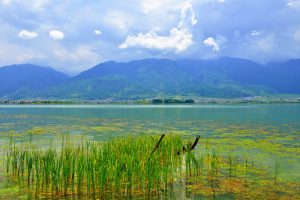
Erhai Lake Park consists of the Haixin Pavilion, swimming pool, promenade, zoo, botanical garden, flower garden and the place for fishing. To the south of Wanghai Tower, there is a colorful garden. All kinds of Dali famous flowers like camellia, rhododendron, plum, lily, compete for beauty. On the north side of the sea promenade is 300 grades of bluestone steps that are more than 3 feet wide, like a waterfall rushing down, directly to the beach in the middle of the park.
Tuanshan Hill(团山) stands in the park. It was the hunting place for royal family in the ancient time. It was a island of Erhai Lake before. With the changing environment, it became the hill beside the lake.
When the weather is fine in Dali, the sunshine is heated, and ultraviolet light is strong. People should avoid direct sunlight, and the sun hat preparation is required during outdoor activities, a pair of sunglasses will make you comfortable in the trip.
Chinese Name:楚雄太阳历公园
English Name: Ten-Month Solar Calendar Park, Chuxiong
Chuxiong is a fascinating land fostering an age-old minority with brilliant culture, among which the Ten-month Solar Calendar is the most striking one. According to this calendar, one year was divided into ten months in five seasons. There were 36 days in a month and two months constituted a season. So, the total was 360 days. The rest 5 or 6 days were defined as annual festival.
It shows that the revolution time of the earth rounding the Sun was 365.25 days, It’s the most precise ancient calendar then and in the long years to come. It is not only a treasure with great scientific and humanistic value in Yi’s culture, but the intellectual crystallization of Chinese people, the cultural heritage of the whole world.
The Ten-month Solar Calendar Park, constructed with the aim to show the quintessence of the world civilization, is a place combining the study of ethnic culture, the demonstration of folk custom, the exhibition of local art, and the trade and entertainment together. It is undoutfully an unique assembly of the marrow of the Yi heritage and a dynamic museum of the Yi culture.
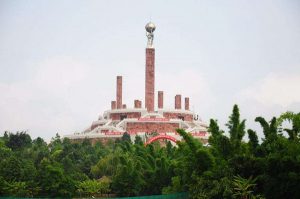
Situated in the suburb of Chuxiong city, The Ten-month Solar Calendar Park covers an area of more than 500 mu. With its own feature and the beautiful landscape of Chuxiong around, it is absolutely a great place for tourists.
Bishan Tiger is found under the roof of almost every house in the residence neighborhood of Yi ethnic groups. Some of them are made from stone, some from mud, and some from wood. Whenever a new house is built, the owner will choose a lucky time, asking people to recite or chant scriptures, praying to Buddha while the Bishan Tiger is put under the roof. It is believed such a tiger may protect those who live under the roof from all the devils and bad luck. Goddess of gourd£º This was the worship of maternal procreation in the early Yi era.
It is also an important part in the totem of the Yi ethnic groups. Dancing of the Yi people£º This scene shows how Yi people of different areas and ties dance when the festivals come, including the left foot dance and three stamping dance in the Chuxiong area, the female moon dance and the cigarette case dance in Honghe area, the carrying of bride, fighting of bulls, wrestling, the dance of March, the dance of dress competition and so on. The Ten-month Solar Calendar Square This is a round square covering 5220.4 square meters with three stages.
The low stage is 72 meters in diameter and 8.4 meters in height; the middle stage is 54 meters in diameter and 5.7 meters high. The upper stage is 36 meters in diameter and 4.2 meters high. All together there are about 40 embossments on the surface of the stages, telling the major folk stories abut the Yi people. The embossments inscribes 7275 people of different characters and 1858 animals of different shapes, which boasts to be one of the greatest embossment groups in China.
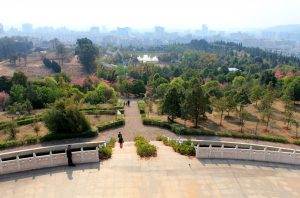
Memorial Altar
The ten-month calendar is based on the observation of the move of the sun and the position of the Big Dipper, which is scientific, simple and easy to understand. This altar tells exactly how the ten-month solar calendar works. Ten animals for ten months In the ten-month calendar there are ten animals which are used to symbolize the ten months in a year. It begins with black tiger of January, followed by otter of February, crocodile of March, python of April, pangolin of May, muntjac of June, rock sheep of July, monkey of August, panther of September, and lizard of October. Because of this reason, the ten-month calendar is also called the ten animal’s calendar.
Travel Tips
The calendar is created by the Yi people almost 5000 year ago. According to this calendar, one year was divided into ten months in five seasons. There were 36 days in a month and two months constituted a season. So, the total was 360 days. The rest 5 or 6 days were defined as annual festival. It shows that the revolution time of the earth rounding the Sun was 365.25 days; it’s the most precise ancient calendar then and in the long years to come.
Yanyue Park in Nanjian County is one of the Best Tourist Attractions and Top Things to Do when travel to Dali, it introduces the main scenic spots, address, entrance tickets booking, The best time to visit, How to Get there, the highlights, facts, history, photos, visiting routes, travel tips, tour maps of Yanyue Park in Nanjian County(南涧县偃月公园).
Chinese Name: 南涧县偃月公园
English Name: Yanyue Park in Nanjian County, Dali
Location: Nanjian County, Dali
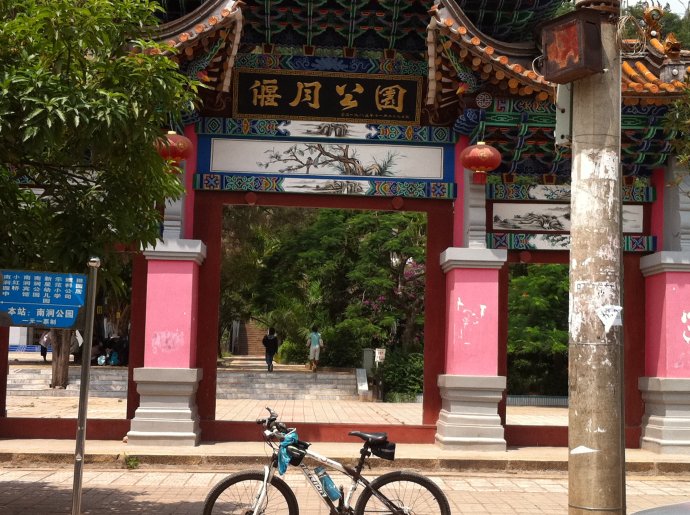
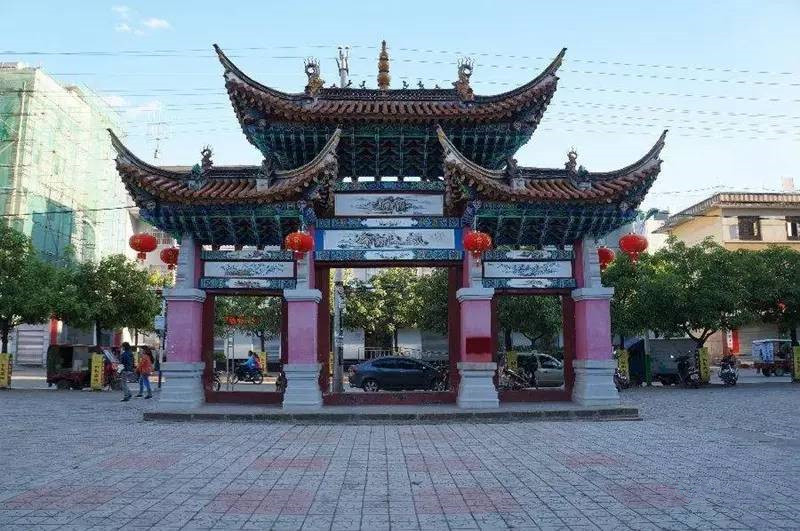
南涧彝族自治县地处东经100°06′~100°41′,北纬24°39′~25°10′,位于大理白族自治州南端。东与弥渡县接壤,南与景东县以澜沧江为界,西至黑潓江与凤庆县隔水相望,北与巍山县山水相连。全县东西最大横距55千米。
南涧西汉时属益州郡,东汉时属永昌郡,蜀汉时属云南郡,唐初属阳瓜州,南诏时属蒙舍赕,宋时属天水郡。元忽必烈至元二十年(1275年)始建县,称名定边县,属镇南州。至元二十四年(1287年)定边县改为乡,仍属镇南州。明洪武十七年(1384年)复置定边县,属楚雄府。清雍正七年(1729年)裁定边县,归蒙化府。民国属蒙化县。
偃月公园月牙山,又名马鞍山,位于南涧县城北边。据康熙《定边县志》记载:“北山偃月,县北有山,两峰相加,高出云表,望之形似偃月。”山峰方圆近万米,海拔1591米,“北山偃月”,是月牙山胜景的嘉喻。秋天昼夜相交时,此地往往出现日月落于同时,晨夕之辉相映若隐虹。
南涧偃月公园坐落于南涧县城北面月牙山上。月牙山是南涧县古往今来的风景名胜,而且也是古代的文化遗址,月牙山上曾出土过新石器时代的石斧、石刀、陶片等文物。因地势险要独特,风景优美,月牙山属古定边(南涧旧称)“八景”之一。1982年,南涧县在月牙山原有风景的基础上建成“偃月公园”。经过30年的不断绿化美化,如今的偃月公园已成为绿树成荫,鸟语花香的绿色公园,成了南涧当地群众休闲娱乐、锻炼身体,外地游人观景游乐的好去处。
记得上世纪八十年代初,我第一次逛南涧偃月公园时,月牙山上树木稀少,除了不多的几株树和山坡上的仙人掌外,植物不多,还能看到黄土裸露的山坡。然而今年中秋节期间当我和朋友又一次来到偃月公园时,月牙山已全部掩映在绿色之中,山坡上的几个小亭子也只露出一点尖顶,通往山顶的石阶小径全部隐没在绿色之中,从山顶“观景台”远眺,南涧县城尽收眼底,往山脚看“偃月公园”尽在绿色之中。而在月牙山脚的公园广场上,高大的榕树、棕榈树下有人跳健身舞、有人遛鸟、有人打球、有人看书……偃月公园已成了南涧群众休闲娱乐的绿色公园。
古人有诗赞赏此景曰:
崔嵬不可喻,伫望接辰居。
日出霞光灿,风高淑景余。
半湾悬海角,全曲到天衡。
云表浮丹气,彤弓带紫鱼。
月牙山不仅是南涧古往今来的名胜名山,而且也是古代文化遗址,曾出土新石器时代的化石,如石斧、石刀、陶器等文物,还有一些地下文物有待发掘考证。http://www.sohu.com/a/152490038_99901123
http://www.dalidaily.com/huanbao/20110922/095628.html
Haimen Park海门公园 is also called Jieyushi Stone Park界鱼石公园. It was named after Jieyushi park because there was a boundary fish stone(Jieyushi in Chinese). Since the Ming Dynasty, local officials and literati had written inscription and poems on the boundary fish stone(Jieyushi). There is also a Guanyin Temple beside Jieyushi, which was first built in 1877. After dredging the river course in 1987, Haimen tower海门楼, Haimen Bridge海门桥, Wangying Pavilion望瀛阁 and other buildings were built here, and the bridge corridor was set up as Haimen Park.
There are also a large number of Cultural landscapes and Stone Carvings related to Jieyushi Stone in the Park, which make Haimen park a multi-level, multi-scene scenic spot and attract more and more tourists from home and abroad.
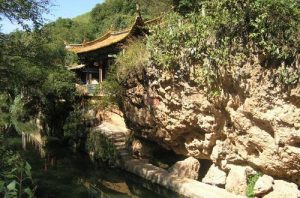
Jieyushi Stone is located in Haimen Village of Jiangcheng Town, Jiangchuan District. Haimen is the outlet of Xingyun Lake, here there is a channel connecting Xingyun Lake and Fuxian Lake, which is called separated river隔河(Gehe in Chinese Pingyin). Gehe River is 2 kilometers long, and there is a craggy stone wall extending to the water surface in the river, which is called the boundary fish stone(Jieyushi). The Jieyushi belongs to carbonate gravel, and there are dissolution pores formed on the stone walls by dissolution in geological period. The Beian Mountian where the stone is located, is wooded. On the boundary fish stone(Jieyushi), engraving “界鱼石” three Chinese characters.
It is said that bullhead大头鱼 in Xingyun Lake and anti-wave fish(Kanglang Fish) in Fuxian Lake, which make the Jieyushi Stone as boundary. They will turn around when reaching to the stone.
1. Biyun Mountain碧云山
Biyun Mountain, located behind the Mingxing village of Jiangcheng Town, has Fuxian Lake in front of it. On the right is the “Yingshange应山歌”, and on the left is the “Anti-wave Fish Cave抗浪鱼洞.” Biyun Temple is on Biyun Mountain, also known as “Wudang Yard武当别院”, is a branch of Hubei Wudang Mountain, built in the Qing Qianlong period.
2. Gushan Mountain孤山
Gushan Mountain, formerly named Yinghai Mountain瀛海山, is located in Jiangchuan part of Fuxian Lake, about 17 kilometers from Jiangchuan district. Before the Ming Dynasty, there was an island near Yinghai Mountain, and there was an iron bridge between the two islands. The late Ming dynasty, an earthquake made the island and Hongyin Bridge虹饮桥 sink, only Yinghai Mountain stands alone, so Gushan Mountain got its name.
3. Mingxing Scenic Spot明星景区
Mingxing scenic spot is located in the West Bank of Fuxian Lake, the junction of Jiangchuan District and Chengjiang County, 12 kilometers away from Luchong禄充. On the west side of the highway from Chengjiang to Jiangchuan, there is a Biyun Mountain. On the third day of the third lunar month, it is the temple fair day of Biyun Temple. Most of Central Yunnan people will come here at that time.
Mingxing scenic spot includes Mingxing fish cave明星鱼洞 and Biyun mountain碧云山 two major scenic spots. Mingxing fish cave is located on the west bank of Fuxian lake, about 1 km from Mingxing village, Jiangchuan district, Yuxi city.
4. Xingyun Lake星云湖
Xingyun Lake is located in the north of Jiangchuan district, commonly known as Jiangchuan Sea江川海. It is separated from Fuxian Lake by a mountain and is connected to Fuxian Lake by a river. The lake is clear and dark green, transparency about 1.5 meters. Xingyun Lake is also rich in Jiangchuan Bullhead and whitebait, which are famous nationwide.
5. Lijiashan Bronze Museum李家山青铜器博物馆
The museum has eight exhibition halls, among which the bronze exhibition hall displays 279 of the more than 2,000 cultural relics. They are classified into production, life, military, dance and decoration according to their functions and uses.
Tourists have two ways to get to Haimen Park, long-distance bus and train.
1. By Long-distance Bus
You can take midibus from Kunming East Bus Station to Jiangchuan District. It takes about 2 hours and a half to take the bus. After arriving at Jiangchuan District, you can take the regular bus to Mingxing明星 or Chengjiang澄江, and get off at Jieyushi Stone界鱼石. It’s about 19 kilometers.
2. By Train
If you want to take train, you should go to Yuxi station first, and then take the bus or taxi to Jiangchuan District. You will spend about 1 hour and 15 minutes on the train. The lowest ticket price is CNY 16.5. Then you will arrive at Haimen Park after about 1 hour drive.
You can stay in Jiangchuan District for overnight, or stay around the scenic spots like Fuxian Lake Scenic Spot and Gushan Scenic Spot.
1. Shengyang Fashion Hotel玉溪江川盛阳时尚酒店
Address: Jiangtong Road, Jiangchuan District, Yuxi玉溪市江川区江通路
Tel: 0877-8081999
Starting Price: 169 CNY
2. eStay Resort (Fuxian Lake Jiulong Shengjing)一呆公寓. 抚仙湖九龙晟景
Address: Jiulong Shengjing, West Bank of Fuxian Lake, Jiangcheng Town, Jiangchuan District, Yuxi玉溪江川区江城镇抚仙湖西岸九龙晟景
Tel: 18787733698
Starting Price: 199 CNY
3. Yuanchen Resort Hotel抚仙湖元尘度假酒店
Address: No.20, Xujia Village, Longjie Subdistrict, Chengjiang County, Yuxi玉溪市澄江县龙街街道许家村20号
Tel: 0877-6688708
Starting Price: 674 CNY
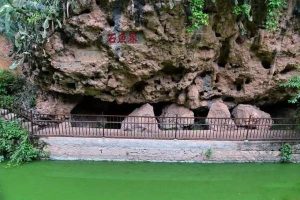
Enjoying a subtropical monsoon climate, tour is possible all the year round. You can go to Haimen park in every season, for the different seasons have unique scenery for people to choose.
1. Ultraviolet ray is strong in Yuxi during sunny days, when you travel at Haimen Park, remember to bring sunglasses, sun cream, sunhat or other sunscreen products.
2. Xingyun Lake and Fuxian Lake on the both sides of Haimen park are deep, therefore, if you are not good at swimming, please wear the life vest when you are doing some water sports.
3. Haimen Park is close to Xingyun Lake and Fuxian Lake, which are two beautiful lakes. There are many scenic spots near Fuxian lake.
Tonghai Xiushan Park, located in the south of Tonghai county, Yuxi city, Yunnan province, is one of the important scenic spots in Yuxi. The peak is 2060 meters above sea level, with a vertical height of nearly 200 meters, covering an area of 7.6 square kilometers, a sightseeing area of 1.55 million square meters and a building area of more than 50,000 square meters. Xiushan mountain is a historical and cultural park. Tonghai Xiushan mountain, together with Jinma mountain金马山 and Biji mountain碧鸡山 in Kunming, as well as Cangshan mountain苍山 in Dali, was named as four famous mountains in Yunnan during the Ming dynasty. There are Sanyuan palace三元宫, Puguang temple普光寺, Jade emperor pavilion, Qingliangtai清水台, Wanshou palace万寿宫, Doutian pavilion斗天阁, Yongjin temple涌金寺, Bailong temple白龙寺 and other ancient architectural complex. It is now a national 4A class tourist area.
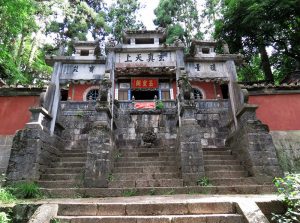
Xiushan Mountain Park is one of the most important scenic spots in Yuxi, with lush trees, numerous ancient buildings and couplets. The rare Song Cypress宋柏, Yuan Cedar元杉 and Ming Yulan明玉兰 on the mountain are honored as “three unique三绝”. Xiushan Mountain is known as “Baishan Lianhai匾山联海” and “stela forest”, and the retained inscribed tablets and stelas have formed a scenic spot featuring human landscape and rare ancient wood. Climb up to the Xiushan mountain and enjoy the scenery of Qilu lake, Tonghai county and basin. During festivals, many people come to pray.
In the middle of Xiushan mountain, Puguang temple was built in the ninth year of Chunyou(淳佑九年) in the south Song dynasty (AD 1249), namely, the 11th year of Daolong in Dali Kingdom(大理国道隆十一年). Puguang temple architectural complex contains Zhiguang Hall置观堂, Panfu Ancestral Hall畔富祠, Panfu Tower畔富塔 and Xibo Pond洗钵池, etc, which is one of the oldest architecture in Xiushan mountain.
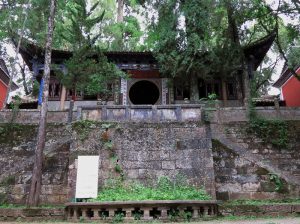
The original name of the Qingliangtai was Qingliang temple, and Qingliangtai was after the Jade Emperor Pavilion. Qingliangtai was built in the late Tang dynasty. In 1478, the monk Jingzong净宗 of Puguang temple reestablished it. Qingliangtai architectures such as Haiyun tower海云楼, Qianfeng Wanhe tower千沟万壑之楼, Penglai pavilion蓬莱阁, Luxian Ancestral temple鲁贤祠, Guixiang hall桂香殿, Wuhou temple武侯祠, and Yaowang hall药王殿 are connected into a whole of four-yard and three-way architecture.
Yongjin temple, located at the top of Xiushan mountain, was founded in the Song dynasty by the emperor Jiaxi嘉兴(AD 1237-1240), and repaired in the Yuan dynasty(AD 1340-1368). Nearly a thousand years, as the temple of central Yunnan, there are more than hundred monks in the temple during Ming and Qing dynasty. Yongjin Temple, also known as Dading Temple大顶寺, is the highest architecture on Xiushan Mountain, covering an area of more than 6000 square meters.
Bailong temple, located in the deep forest on the west of Yongjin temple, was founded in 1486. In recent years, part of galleries and service facilities have been expanded, leading water up the mountain, digging the pool to cultivate lotus and various flowers and plants, which has become a new tourist attraction of Xiushan mountain park. The new attraction architecture complex, located in front of the Bailong temple, was built in 1988. It contains Bbaiyun dock白云坞, Sizhu pavillion丝竹馆, painting and calligraphy exhibition room, pool gallery, wealth temple, orchid garden and tea garden.
5. Tonghai Confucious Temple通海文庙
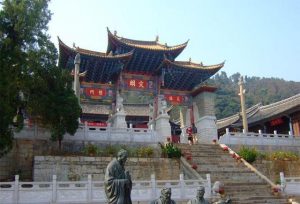
Tonghai Confucious temple is located at the south of Tonghai county. The Confucious temple consists of Wenmingfang文明坊, Zhonglie Ancestral Temple忠烈祠, Jiexiao Temple节孝祠, Dachegn Gate大城门, Minghuan Temple名宦祠, Dongwu东庑, Xiwu西庑, Dacheng Palace大城殿, Chongsheng Temple崇圣祠 and Zunjing Pavillion尊经阁, covering an area of 12,000 square meters. Tonghai Confucious Temple was built in Yuan dynasty and moved to present site in Wanli of Ming dynasty.
Xiushan mountain historical and cultural park is located in the central and south of Yunnan. It has more than 2000 years history until now. Built on a large scale in the Tang dynasty and experienced Song, Yuan, Ming and Qing dynasties, seven ancient architectural complexes of grand scale, grand momentum and different styles were formed. Xiushan mountain covers a total area of 1.55 million square meters. There are 250 plaques, couplets, stelas inscribed by scholars in various dynasties.
Tour at Xiushan Mountain Park is available all the year round.
1. By Long-distance Bus
There are non-distance buses from Kunming to Tonghai County. Xiushan Mountain is on the edge of the Tonghai County, after arriving in Tonghai County, you can walk along the south street to Xiushan mountain park. In addition, you can also take train.
Kunming East Bus Station-Tonghai Bus Terminal
Departure Time: 6:58-18:00
Ticket Price: 42 CNY
Distance: 138 Kilometers
Consume Time: About 2.5 hours
2. By Train
Kunming Station-Tonghai Station
Departure Time: 15:41
Ticket Price: 21.5 CNY
Distance: 139 Kilometers
Consume Time: About 2 hours
You can stay at the county seat of Tonghai County because Xiushan Mountain is not far from it.
1. Tonghai Landun Hotel通海兰顿酒店
Address: No.72, Liyue West Road, Xiushan Town, Tonghai County, Yuxi玉溪市通海县秀山镇礼乐西路72号
Tel: 0877-3098888
Starting Price: 114 CNY
2. Tonghai Mingbang Hotel通海名邦大酒店
Address: No.219, Xiushan West Road, Sangyuan Industrial Zone, Tonghai County, Yuxi玉溪市通海县桑园工业区秀山西路219号
Tel: 0877-3058999
Starting Price: 145 CNY
3. Tonghai Diannan Hotel通海滇南大酒店
Address: Liyue West Road, Xiushan Town, Tonghai County, Yuxi玉溪市通海县礼乐西路
Tel: 0877-3078888
Starting Price: 173 CNY
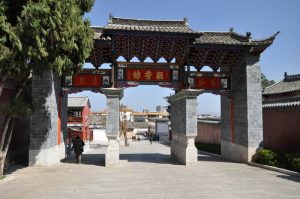
1. Ultraviolet ray there is strong during sunny days, you should bring sun cream, sun glasses, sun hat or other screen products.
2. During the rainy season(Around June to October), the road conditions could be dangerous.
3. Mountain area is prone to natural disasters, so try not to go out in heavy rain.
4. Located on Xiushan mountain in Tonghai County, the temperature difference at Xiushan Mountain park is relatively large. You are supposed take coats to prevent a cold because of the large temperature difference from daytime to night.
13 Days Yunnan Muslim Culture Discovery Tour
Xishuangbanna Primeval Forest Park
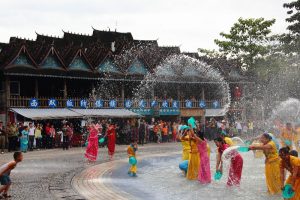
Xishuangbanna Primeval Forest Park, also called Xishuangbanna Virgin Forest Park, is 8 kilometers east of the Jinghong City and north of the Lancang River. Situated in a river valley of 720 to 1,355 meters above sea level, the forest park has an area of 1,700 hectares of which 98% is covered by trees, and is thus the largest comprehensive ecological place of interest in the prefecture. The park gives prominence to the features of primeval forest, wild animals and ethnic culture and custom. It is highlighted by three major themes: primeval forest, wild animals and ethnic folklore. And you can also enjoy and play a part in the local ethnic activities such as the Dai Water Splashing Festival, Aini capture marriage custom and the grand ethnic performances
Park locates in a valley, famous for its three main characters –Primitive Forest, Wild Creature and Minority Culture. The whole park can be divided into 6 areas, which are Reception Area, Outdoor recreational Lounge, Sightseeing Area, Forest Reserve Area and Fruit Trees Area, Recreational Center, etc.
Xishuangbanna primitive forest park provides a unique primeval forest natural scenery and charming ethnic customs. Chinese National Geography magazine rewarded it as one of China’s top ten most beautiful forests.
In the Primitive Forest Protection Zone, you will have chance to find out several types of trees which be referred to as “live fossil”, like Homalium, Cyathea Spinulosa and Podocarpus Imbricatus Blume, etc. Giant Parashorea Cathayensis is also an amazing site in this zone.
Xishuangbanna Primeval Forest Park is 8 kilometers east of the Jinghong City and north of the Lancang River, in a river valley of 720 to 1,355 meters above sea level. It is in the edge of the northern place of south of the tropic of cancer.
● Travelers can take Flower Garden-Forest Park Bus in the Bus Station near Jingyong Restaurant. Buses departure every one hour from 8:00 to 12:00 a.m. The departure time in the afternoon are 15:00, 16:30 and 17:30. The bus ticket is RMB 5.
● Taking bus from Jinghong to Mengyang or the taking original forest park dedicated shuttle for visitors to get there.
● The west side of Jinghong is long-distance bus terminal, there is shuttle bus to reach the forest park for tourists. The fare is 3 Yuan.
The park boasts 10 scenic areas such as the well-preserved Ravine Tropical Rainforest in the south of Tropical of Cancer, Peacocks Raising Base, Monkey Taming Base, Cultural Show Plaza, Ai’ni (a branch of the Hani minority) Village, Nine Dragon Waterfall, Manfeilong White Pagoda, 100-meter-long Granite Relief Carvings, Jinhu Lake Folklore, and Barbecue Rank etc.
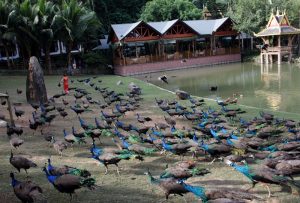
At the heart of Xishuangbanna Virgin Forest Park is the Peacock Park. The Peacock Park recreates the legend of Jinhu Lake, complete with an artificial lake. According to legend, Jinhu Lake was where Princess Namnu Nuona and Prince Zhao Shutung got to know each other and fell inn love.
Legends of Peacock
Xishuanggban is widely crowned as “The Home of Peacock”, because there are a lot of peacocks living in Xishuangbanna. Peacock owes a holy position among Dai people and is the totem of Dai people. Peacock stands for happiness, beauty, goodness and luckiness.
Peacock plays an essential role in locals’ daily life. Visitors can find that some folk customs and events such as the ritual of worshiping ancestors, Legend between Prince and Peacock Princess are related to peacock.
The Legend between Prince and Peacock Princess
According to the local narrative poem, there are seven princesses from heaven once came to the Jihu (literally Golden Lake) to take a shower. And the prince named Shaoshu saw the seven princesses were playing around the lake when he passed along the lake by elephant.
Prince Shaoshu and the youngest princess named Nannuona fell in love with each other at the first sight when they met. They finally become a couple.
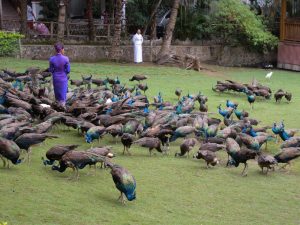
● Flight of a Thousand Peacock
The highlight of Peacock Park is the daily Flight of a Thousand Peacock, a performance involving one thousand peafowls. They flew out of their sanctuary to land on the lakeside, where they were fed, before eventually returning to their sanctuary on the opposite bank of the lake. Visitors are invited to feed the peacocks as well as to have their photographs taken with them.
● Bear Show
In addition to the peacock show, there are also performing bears – it is something which made me feel a bit uneasy, as I am concerned whether the bears were mistreated. At the end of the show, the bear was so smart they it could pick up its own pedestal and take it out of the cage.
● Nine-Dragon Waterfall
The Nine-Dragon Waterfall is a waterfall within the Xishuangbanna Virgin Forest Park. In front of the waterfall is a statue entitled Jiulong Subduing Nine Dragons. There is also a pavilion here where tribal performances are stage. You can also try out some local candy on sale at the stall near the waterfalls.
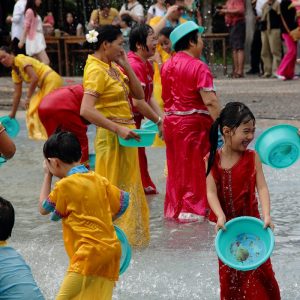
● Ainu Village
Located within the Xishuangbanna Virgin Forest Park is an Ainu cultural village. In this village, we get to know the Ainu people, their history and lifestyle. There are also songs and dance performance, and welcome dances where visitors are invited to join in.
The Ainu village is reached via a suspension bridge. It spans a river below. An alternative to using the bridge is to cross the ravine by glider.
Jiangchuan ancient Dian culture park江川古滇文化公园 is a national AAA level scenic area, the first “sleepless island” in Yunnan province and a provincial scenic area. It is located in China’s deepest plateau freshwater lake, Fuxian lake of Jiangchuan District江川区. The transportation to ancient Dian culture park is convenient, and annual average temperature there is about 20 ° C. Gushan mountain孤山 is located in the west water area of Fuxian lake and is the only mid-lake island in central Yunnan. The island is spring all year round, the air is fresh and the lake is blue and bright. With Gushan孤山 island as the core area and relying on the profound ancient Dian bronze culture connotation of Lijiashan李家山 in Jiangchuan District, the ancient Dian culture park has become a leading tourist scenic area in Fuxian lake after years of development. It is a comprehensive tourist area integrating sightseeing, conference leisure, as well as fitness and vacation.
The ancient Dian culture park is located in Fuxian Lake of Jiangchuan District, Yuxi City, Yunnan Province. It is also known as Gushan island孤山岛, is the only island on the whole Fuxian lake.
There are complete tourism facilities in ancient Dian culture park. The one package service integrates adventure, odd, serene, elegance, accommodation and recreation, so that people can be in a quiet and elegant place and escape from the noisy world. The culture park takes fully advantage of precious natural landscapes, rich and unique fish culture, human resources with long history, fresh and natural rural scenery.
The ancient Dian culture park, taking the ancient Dian bronze culture as the soul and the scenic Gushan island as the spatial carrier, introduced the profound and splendid ancient Dian culture into the tourism development. In virtue of natural resources of Fuxian lake and Gushan island, ancient Dian bronze culture was displayed. At the same time, with the help of the ancient Dian bronze culture, cultural connotation of the culture park tourism development has been increased and enriched. The natural landscape and human landscape, which are both wild and artificial, reflect the main features and functions of the culture park.
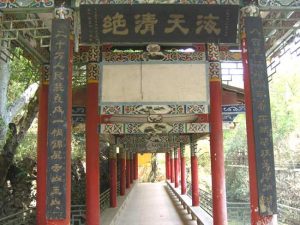
More than 2,000 years ago, there existed the ancient Dian kingdom with splendid culture in the region of Yunnan, centering on “two mountains(Lijiashan李家山, Shizhai mountain石寨山)” and “two lakes(Dianchi and Fuxian lake)”, among which the Lijiashan bronze culture was the main representative of the ancient Dian culture. The ancient Dian culture park was originally named Gushan孤山 scenic area, which started in Tang dynasty and flourished in Song dynasty superior to Ming dynasty. At the end of the Ming dynasty, eight halls, five lofts, three pavilions, a temple, a nunnery and a pagoda are built on the island. In 1979, it was taken over by the institute of biology, Chinese academy of sciences, and became the well-known monkey island. In 1988, the Gushan scenic area was rebuilt, with trees and flowers planted and new pavilions built. It was opened to the public in 1993. In 2004, it was renamed and registered as “Jiangchuan ancient Dian culture park江川古滇文化园”.
The golden seal of Dian King
The golden seal of the Dian King was unearthed in the tomb of the Dian King Changqiang at Shizhaishan Hill on December 28, 1956.
It was a sensational archeological discovery in Yunnan Province for it strongly proved that the Dian Kingdom in the legend really existed in the Dianchi Lake area 2000 year ago and politically related with the Han Dynasty because the golden seal was presented to the Dian King by Emperor Hanwudi in the West Han Dynasty (109BC).
The archeological discovery of the Dian Bronze wares are of many kinds: cowry containers (bronze drums), musical instruments, ritual vessels, weapons, farming tools, textile tools, articles for daily use, decorative appliances and so on, which were of Dian cultural ecstasy or essence and strong Yunnan ethnic styles. Showing the masterful casting technique of modeling, filling model casting, dewaxing model casting and artistry and the skilled use of the bronze alloy as well as the successful experience, Dian Bronze gained high position in the four bronze cultures of the world including the Greek bronze culture, Central China bronze culture, Dian bronze culture and North China prairie culture.
The archaeological circles traditionally refer to the bronze culture which appeared in the Dianchi Lake area from the Warring States period to the Eastern Han Dynasty as “Dian Culture” and named it “the Culture of Shizhaishan Type” because it was discovered first at the Shizhaishan Hill in Jinning County. The bronze exhibits in Kunming City Museum are just the the bronze culture in the Dianchi Lake area, an excellent art among the splendid Chinese bronze cultures of the profound historical and cultural background.
With Dianchi Lake area as the centre, the Dian bronze cultures are widely distributed in central Yunnan including Qujing to the east, Yuanjiang to the south, Jinshajiang River to the north, and Lufeng to the west, and Kunming, Jinning, Chenggong, Jiangchuan, Anning, Lufeng, Shilin, Luliang and Qujing etc are all involved. There are in all 14 counties and over 60 spots included, and the most important spots are the Shizhaishan Hill of Jinning County, Lijiashan Hill of Jiangchuan County, Batatai Terrace of Qujing, Tianzimiao of Chenggong, Shibeicun Village of Chenggong and Taijishan Hill of Anning.
The bronze wares excavated
Cowry containers, cowry are the ringed sea shells from the tropical coast of the Indian Ocean and Pacific Ocean, which means that the Dian ethnics in the inland Yunnan had already exchanged with the peoples along the coasts and they took the sea shells as media currency and especially the ruling class made the bronze container to store the cowries as the plus values. We can say the bronze cowry containers are the forefather of China’s banks and also the forefather of the world’s banks!
The containers
The containers are of different shapes, some are drum-shaped, some are tubular, and some are irregular.
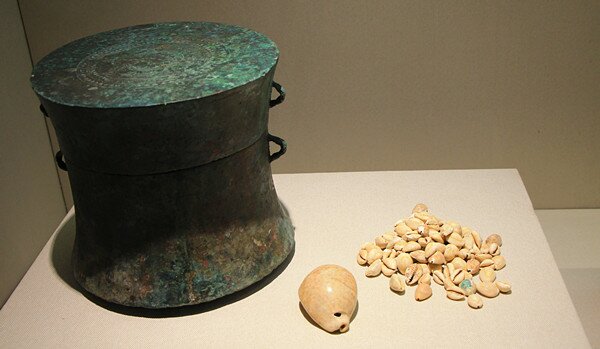
The lids with five cattle, one is relatively big and other four are standing around the edge with tails and heads linked. The bodies have feather men boating patterns and water birds and cattle carved. The cattle were the sign of the property, which displayed the chase and desire of the owners for wealth. There are cast 7 figurines on the body with high air bun, bare feet, with the gong touching the ground and spears on the shoulders–which means there was a well-armed and well-trained army in the Dian Kingdom.

The drums
The drums usually used as the cooking pots first and then used as drums when battles drumming for fight.
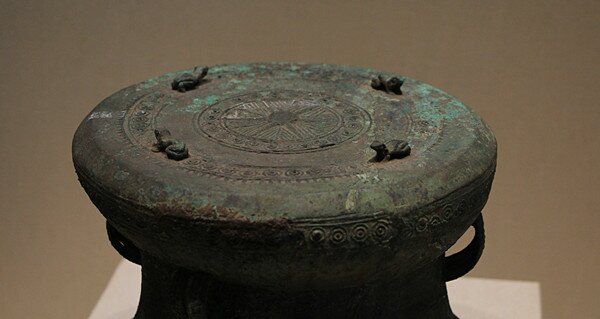
Yunnan is the province where the bronze drums were widely discovered. The bronze drums were not only the musical instruments, but also the ritual vessels and valuable devices, only the royal families and the higher-ups could possess. The 1,400 bronze drums collected in China are classified into eight types of different drums such as “Wanjiaba Type”, “Shizhaishan Hill Type”, “Lengshuichong Type”, and “Majiang Type” etc. The common characteristics of these bronze drums are bronze-made, flat tops and curve bodies, empty inside and no bottom, 4 hangers on the sides.
The drums unearthed at Tianzimiao Temple of Chenggong were the relics of the Warring States period and one of the two, the surfaces had the sun patterns and the main halo were four flying herons around the sun pattern (this is the evidence that there were ever since lots of herons in the Dianchi Lake area), there were round point patterns and triangle tooth veins with round points on the outer halo and this drum was unearthed from the biggest tomb in the central part of the site, and this implied the preciousness of the bronze drum during the Warring State period, the prominent social status and the high nobility of the host. It is noticeable that the plain drums without patterns were the relics of the Spring-Autumn period.
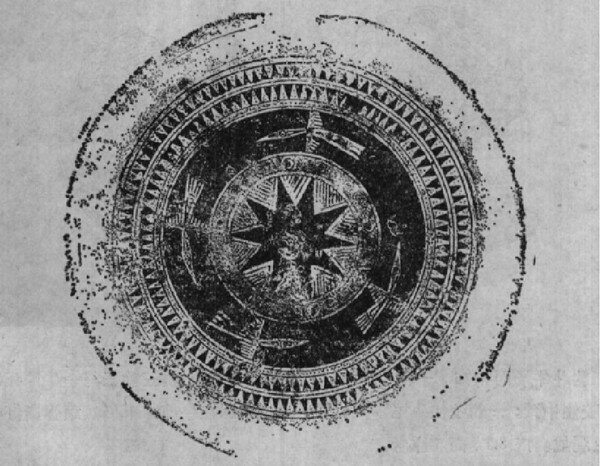
The buckle ornaments
The buckle ornaments were the characteristic artifacts among the Dian bronze wares and usually used as ornaments. They are, by their shapes, rectangular, circular and irregular; while by the casting technology, they are hollowed carvings,mosaic and relief and so on. But any shape or any technology, there must be a hook welded on the back to buckle it on the clothes or on other things.
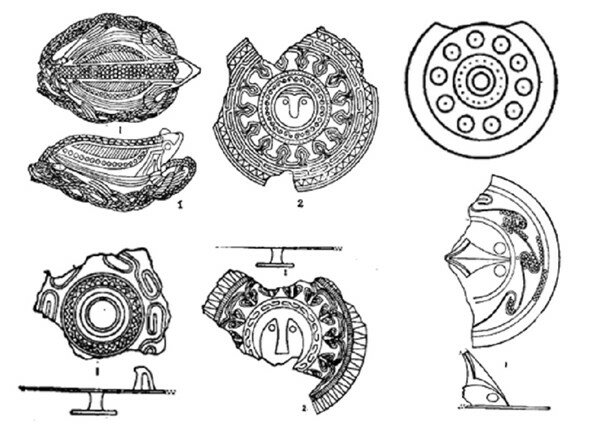
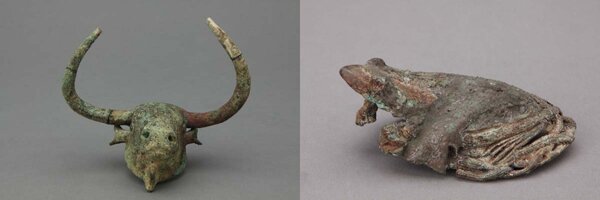
The weapons
The weapons are the bronze wares mostly unearthed in the Dianchi Lake area, more than 70 pieces were unearthed in Tomb 71#, which are dagger-axes, spears, swords, battle-axes, axes, arrowheads, crossbows, maces and so on.
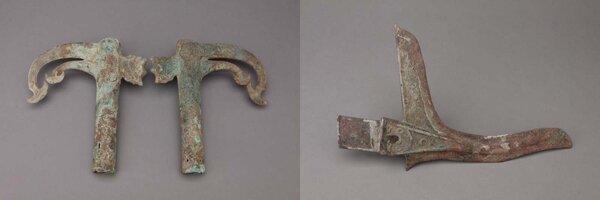
The golden seal of Dian King shows the political status of Dian in the West Han Dynasty;
The cowry containers show the economy of Dian Kingdom;
The bronze reed pipe shows the musical history so long and ancient;
The bronze horn pillow with massage function shows the medical science of the time;
The cattle and tiger table shows the ritual ceremony of Dian society;
The bronze cattle heads show natural religion and worship of the time;
The model house shows the architecture of Dian Kingdom;
The bronze figurines show the clothes style and the head ornament of Dian people which we still can see among the local ethnic people.
Well, with a lot of information of Shaizhaishan Hill and Dian Kingdom, I hope a visit to the Shizhaishan Hill will be fruitful.
1. Lijiashan Bronze Museum李家山青铜博物馆
Located in Jiangchuan District, Yuxi City, south of Kunming, Lijiashan Bronze Museum is about 110 kilometers away from Kunming. Lijiashan Bronze Museum is outstanding cultural relic of national treasure level and a miracle in Chinese bronze culture. These bronze wares not only have historical origins with the bronze culture of central plains and northwest China, but also have distinct national characters of frontier areas. It is of great value for us to study the history of nationality, agriculture and animal husbandry, metallurgy, fine arts, folk customs and so on in ancient China, especially in ancient Yunnan.
2. Xingyun Lake星云湖
Xingyun Lake, located at 1 kilometer from the north of Jiangchuan District, Yuxi, Yunnan Province, is commonly known as Langguang Sea浪广海 or Jiangchuan Sea, with a surface area of 34.7 square kilometers. It is rich in silver carp and Wuchang fish, but it is the most famous for its bullhead fish. Xingyun Lake is a natural fish farm with beautiful scenery around it.
3. Fuxian Lake抚仙湖
Fuxian Lake stretches out through Chengjiang, Jiangchuan and Huaning Counties in Yunnan Province, covering an area of 212 square kilometers. The lake is the third-largest lake in Yunnan, after Dianchi Lake and Erhai Lake. Also it is the deepest lake in Yunnan with 155 meters of its greatest depth. The lake is also the third-deepest fresh water lake in China, after Tianchi and Kanas Lake. It belongs to Nanpan river system. The lake is gourd-shaped with 1053 square kilometers runoff area.
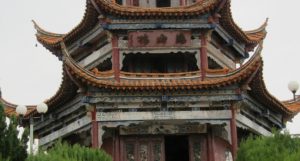
Tourists have two ways to get to Ancient Dian Culture Park, long-distance bus and train.
1. By Long-distance Bus
You can take midibus from Kunming East Bus Station to Jiangchuan District. It takes about 2 hours to take the long-distance bus. It is about 20 kilometers from Jiangchuan bus terminal to Ancient Dian Culture Park, takes about 30 minutes.
2. By Train
If you want to take train, you should go to Yuxi station first, and then take the minibus or taxi to Ancient Dian Culture Park of Jiangchuan District. You will spend about 1 hour and 15 minutes on the train. The lowest ticket price is CNY 16.5. Then you will arrive at Ancient Dian Culture Park after 1 hour drive from Yuxi railway station.
There are hotels around Ancient Dian Culture Park, it is not difficult to find a place to stay there.
1. Fuxian Lake Fuxian Residence澄江抚仙湖抚仙公馆
Address: Jianggu Highway, Gushan Village, Jiangcheng Town, Jiangchuan District, Yuxi玉溪市江川区江城镇孤山村江孤公路
Tel: 0877-8018999
Starting Price: 267 CNY
2. Yangguang Bandao Hotel抚仙湖阳光半岛度假酒店
Address: Fuxian Lake Residence Quarter, Xiaomagou Village Committee, West Bank of Fuxian Lake, Jiangchuan District, Yuxi玉溪市江川区抚仙湖西岸小马沟村委会仙湖岛小区
Tel: 0877-8098866
Starting Price: 155 CNY
3. Fuxian Garden Hotel玉溪抚仙花园酒店
Address: Jianggu Highway, Gushan Scenic Area, Jiangchuan District, Yuxi玉溪市江川区孤山风景区江孤公路
Tel: 0877-8552189
Starting Price: 97 CNY
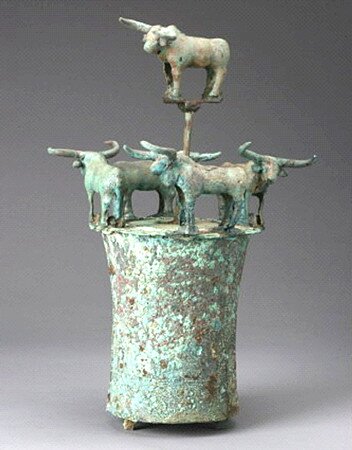
Enjoying a subtropical monsoon climate, tour is possible all the year round. With warmest sun, softest beach and clearest water, Fuxian Lake is a excellent place to escape the heat in summer. From April to October, you can enjoy the natural wonder of Fuxian lake, Black Carp Array青鱼阵.
1. Ancient Dian Culture Park is surrounded by the water area. The air is humid, when changes in the weather, the wind is stronger, be sure to keep warm.
2. Ancient Dian Culture Park is 100 kilometers away from Kunming and 32 kilometers from Yuxi.
3. The water in Fuxian Lake is deep, with 155 meters of its greatest depth. Therefore, if you are not good at swimming, please wear the life vest when you are doing some water sports.
4. Fuxian Lake is a plateau lake, and it is popular in summer. Ultraviolet ray is strong in summer, when you travel Fuxian Lake in summer, remember to bring sunglasses, sun cream, sunhat or other sunscreen products.
Dali Tianbao Park and Wanrenzhong Tombs in Dali City travel guide introduces the main attractions, entrance tickets booking, The best time to visit, How to Get there, the highlights, facts, history, photos, weather, accommodation, visiting routes, travel tips, tour maps of Tianbao Park and Wanrenzhong Tombs in Dali(大理市天宝公园和万人冢).
Chinese Name: 大理市天宝公园和万人冢
English Name: Tianbao Park and Wanrenzhong Tombs in Dali City
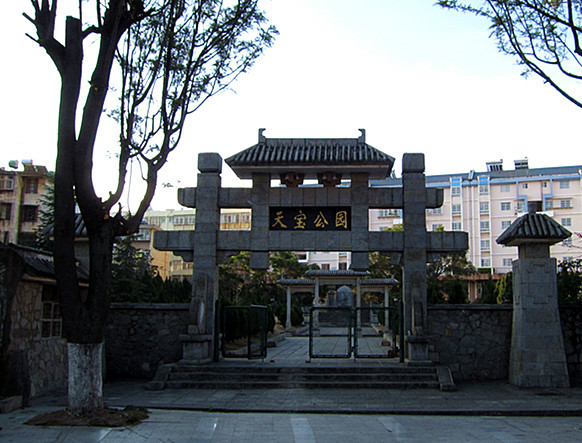
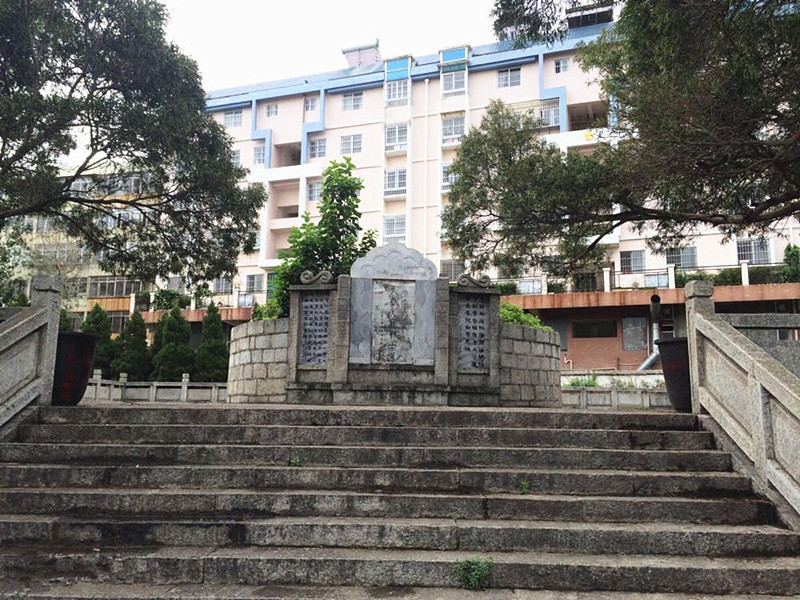
Location:http://blog.sina.com.cn/s/blog_40867fed0102vcdc.html
Chinese Name:绿春县东仰风情园
English Name: Dongyang Hani Folk Custom Park in Lvchun County, Honghe
Honghe Dongyang Hani Folk Custom Park in Lvchun County travel guide introduces the main attractions, entrance tickets booking, The best time to visit, How to Get there, the highlights, facts, history, photos, weather, accommodation, visiting routes, travel tips, tour maps of Dongyang Hani Folk Custom Park in Honghe(绿春县东仰风情园).
The Hani Folk-Custom Park is also called the Aluooubin Folk-Custom Park. It is located in the center of a new district being planned by the Lvchun County and only between two and three kilometers to the legendary Aluooubin Watershed. The Simao-Jinning Highway beside the park goes through and new area and reach the county seat Daxing Town directly. The clear landscapes on the two sides of the park, including green mountain ranges, terraced fields and white cloud, make the park even more beautiful and mysterious.
The entire park covers an area of 34,775 square meters and consists of eight areas of the entrance area, central square area, stage area, dining area, reception area, traditional ceremony area, terraced-field area and parking area.
In the entrance area, there is a giant rock pile. On the two sides of the area, there are two giant drums and two giant trees. After entering the park from the main entrance, you will see the landmark statue of the park: a flying silver pheasant. The base of the statue is the giant tree of the Aluooubin Legend, which is 3.9 meters high. The two-floor round base is 0.6 meters high.
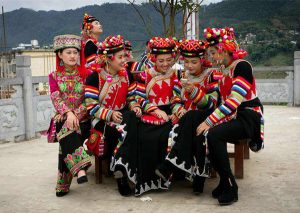
After passing by the statue, you will reach the wide central square area. The square is a square-outside and circle-inside shape, looking neat and tight. The four corners of the square are four tea gardens where tens of thousands of tea trees are planted. Tea is very important to the Lvchun Country and is an economic pillar of the county. A very renowned tea type of the county is called the Mayu Tea, which could be a very good gift for friends. The central square is the place for holding large folk activities and the diameter of the central circle is as long as 99 meters. It is the largest central square in the whole prefecture, and there is also a music fountain with a diameter of 50 meters on the square.
In the center of the park is a mushroom building with strong Hani flavor. Its structure was mainly made of wood. The pillars and crossbeams are all very thick. The house is very dry, warm in the winter and cool in the summer. On the first floor are a cultural activity room, a reference room and the office of the Tourism Bureau of the Lvchun County. On the second floor are a folk-custom exhibition hall and two multi-functional exhibition halls. On the third floor are mainly a library and some reading rooms.
Since designers of the park attached great importance to the greening of the park in the beginning, the current green area of the park is 18,938 square meters and the greening ratio of the park is as high as 56.9 percent. On the two sides of the green stone road, various kinds of trees, including the various palm trees and spindle tree ferns, are planted, and you could smell the tinges of spring anywhere. There are also some small reception buildings in the woods for tourists, which are made of raw woods and mud outside but have modern facilities inside. Beside the reception buildings, there are also amusement facilities, such as the traditional Moqiu square of the Hani nationality and folk activity square, for tourists to participate in the folk activities of the Hani nationality personally.
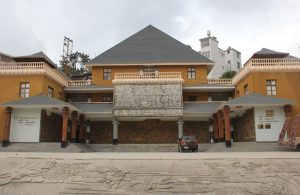
The traditional ceremony platform is at the traditional ceremony area of the park. The semicircular-shape platform all various nationalities to held their various ceremonies is in the center some small-leaved banian trees and giant rocks. Tourists could personally participate in the ceremonies of the Hani nationality’s June Festival, October New Year and Dragon Worshiping Festival.
The dining area of the park is a relatively large mushroom building. It has five floors, each of which has a mushroom-like cover. The building covers an area of more than 600 square meters and is well equipped with dining facilities. Tourists could enjoy real Hani food and the wine named Mountain Spring made by the Hani people.
World Butterfly Ecological Park, located in Kunming, Yunnan Province town of Xishan District Biji black buckwheat mother village, where simple folk, beautiful environment, fresh air, natural no dirt, the forest coverage rate to 98%. Negative oxygen ions up to 20,000 / cm3 or more. Group is tourism, sightseeing, vacation, leisure, entertainment, education and Adolescent Medicine butterfly breeding, viewing, processing, scientific research as one of the major eco-tourism park.
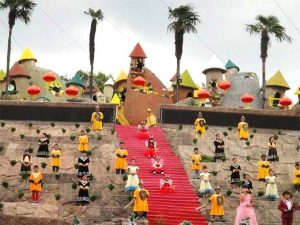
The World Butterfly Ecological Park will be completed in three phases with an investment of 880 million yuan. The Pearl Tower in the west of the second phase of the project is expected to be completed by the end of this year. Due to the relatively high topography standing on the Pearl Tower in the west, Dianchi Lake, Kunming, and an overview of the peace, the roads have now been built. At the same time as the opening of the first phase of the project, the western Pearl Tower will start construction at the same time. In addition, the third phase of the project will build a hunting ground at the top of Guanyin Mountain, and is still in the filing of the relevant procedures. The fourth phase is the construction of South Asia’s largest leisure resort.
At present, there are about 14000-16,000 species of butterflies in the world. There are 1758 species of butterflies known in China. Yunnan is known as the “hometown of butterflies” in China, and there are more than 700 kinds of butterflies. According to the climatic characteristics and vegetation of Kunming, the World Butterfly Ecological Park introduces 60% of the world’s butterfly species, with a total of hundreds of millions of butterflies, and the density of butterflies will reach the scale of 7 butterflies per square meter.
Park road unobstructed, along the coast and on the high-speed Dianchi kilometer border from the city center, the railway station, the airport no more than 30 minutes, Kunming, after the Expo, and an ethnic village project. Plays a role in promoting the further development of tourism industry in Yunnan Province, not only because of its rare butterflies and teenagers Cape education base film base, or at most butterfly species in the world, the scale of the highest level, the largest number of supply, process manufacturing the finest, best ecological resources world-class scenery big garden. Take time to bring the mood, relax, relieve breathing, leaving downtown Kunming, we travel together. Departure as long as 30 minutes to come to this modern romantic hideaway from Kunming – World Butterfly Ecological Park.
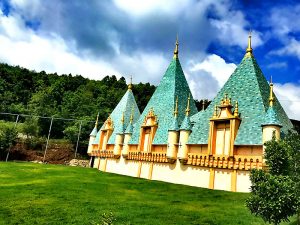
World Butterfly ecological park has three wonders: Live Butterfly Garden, seasons, love regardless of the season, Fall in love with the beauty and freedom, Fall in love with a butterfly garden. Kissing each petal, feel the aura from butterfly fairy, dream sleep in this extremely flowers, leave enough breath, I do not know how many times has experienced reincarnation, seeking only to see here, there is against the background of flowers, butterflies around . Hill lines, spring patter of the sun, happy flowers open each flower, each cheerful butterflies flying into the live butterfly garden to witness the beautiful cicada becomes lovely spirit, and experience the butterfly garden, cocoon moved, Four seasons flowers, butterflies dancing, naughty elf around your flying, sometimes you fall on the shoulders of the foot rest, sometimes secretly kiss your face, mountain flowers, butterflies Manwu, inadvertently, beautiful fantasy butterfly heart is Park open.
The Kingdom of the Little People is a theme park located near Kunming, Yunnan that features comic performances by people with dwarfism. Supporters of the park claim that it provides employment to people who would otherwise be unable to find work, but it has been criticized for treating dwarfism as a humorous condition.
The whole ecological park is a cultural ecological park with butterflies as the main line. The density of butterflies in the garden reaches 4-8 per square meter. The most concentrated areas of butterfly dancing are the Butterfly Pavilion and several “Butterfly trees” in the park; thousands of butterflies can also be brought to the wedding site or where they are needed. In hundreds of acres or more, truly forms throughout the year flowers blooming, flowers artless, throughout the year butterfly flying spectacular scene.
Take the World Butterfly Eco-Park special vehicle. The car set out on time at 11: 30 or 14:30.








Parks
Haishe (Tongue of Erhai Lake) Park Locate in the west bank of Erhai Lake, Haishe Ecological Park(海舌公园) is about 3-4 kilometers away from Xizhou. It is a narrow...
Reflection Park of Three Pagodas Reflection Park(倒影公园) is behind the Three Pagodas, and there is a Reflection Pond in the park which got its name from the graceful clear...
Erhai Lake Park Erhai Lake Park(洱海公园) is a park at the southern end of the Erhai Sea in Dali City, Yunnan Province. It is the first stop to visit the Cangshan...
Chinese Name:楚雄太阳历公园 English Name: Ten-Month Solar Calendar Park, Chuxiong Chuxiong is a fascinating land fostering an age-old minority with brilliant culture, among which the Ten-month Solar Calendar is the...
Yanyue Park in Nanjian County is one of the Best Tourist Attractions and Top Things to Do when travel to Dali, it introduces the main scenic spots, address, entrance...
Why is Haimen Park So Special? Haimen Park海门公园 is also called Jieyushi Stone Park界鱼石公园. It was named after Jieyushi park because there was a boundary fish stone(Jieyushi in Chinese)....
Why is Xiushan Mountain So Special? Tonghai Xiushan Park, located in the south of Tonghai county, Yuxi city, Yunnan province, is one of the important scenic spots in Yuxi. The...
Xishuangbanna Primeval Forest Park Xishuangbanna Primeval Forest Park, also called Xishuangbanna Virgin Forest Park, is 8 kilometers east of the Jinghong City and north of the Lancang River. Situated...
Why is Ancient Dian Culture Park So Special? Jiangchuan ancient Dian culture park江川古滇文化公园 is a national AAA level scenic area, the first “sleepless island” in Yunnan province and a...
Dali Tianbao Park and Wanrenzhong Tombs in Dali City travel guide introduces the main attractions, entrance tickets booking, The best time to visit, How to Get there, the highlights,...
Chinese Name:绿春县东仰风情园 English Name: Dongyang Hani Folk Custom Park in Lvchun County, Honghe Honghe Dongyang Hani Folk Custom Park in Lvchun County travel guide introduces the main attractions, entrance...
Overview of Kunming World Butterfly Ecological Park World Butterfly Ecological Park, located in Kunming, Yunnan Province town of Xishan District Biji black buckwheat mother village, where simple folk, beautiful...
Don't assume you're restricted to the main hubs of Beijing and Shanghai, our tours can start from any city.
For your safety, please register with the Embassy.
Exchange some local currency for your trip
Start planning your tailor-made holiday to China by contacting one of our specialists. Once enquired, you’ll get a response within 0.5~23.5 hours.

Address: Building 4, Yifuyuan, Hehong Road, Xishan District, Kunming, Yunnan, China
Wechat/QQ: 270384698
Office Call: 86-18812220370
Email: Trip@YasoTrip.com
Facebook Page:
https://www.facebook.com/YasoTrip
Tel/WhatsApp: +8618088243690
Trip@YasoTrip.com
Daily: 9:00 am - 6:00 pm
Copyright © 2008 Yaso Trip. All rights reserved
Address: Building 4, Yifuyuan, Hehong Road, Xishan District, Kunming, Yunnan, China
Wechat/QQ: 270384698
Office Call: 86-18812220370
Email: Trip@YasoTrip.com
Facebook Page:
https://www.facebook.com/YasoTrip
Tel/WhatsApp: +8618088243690
Trip@YasoTrip.com
